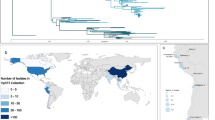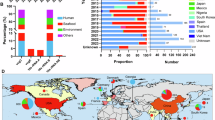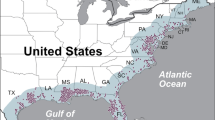Abstract
Humans have profoundly affected the ocean environment but little is known about anthropogenic effects on the distribution of microbes. Vibrio parahaemolyticus is found in warm coastal waters and causes gastroenteritis in humans and economically significant disease in shrimps. Based on data from 1103 genomes of environmental and clinical isolates, we show that V. parahaemolyticus is divided into four diverse populations, VppUS1, VppUS2, VppX and VppAsia. The first two are largely restricted to the US and Northern Europe, while the others are found worldwide, with VppAsia making up the great majority of isolates in the seas around Asia. Patterns of diversity within and between the populations are consistent with them having arisen by progressive divergence via genetic drift during geographical isolation. However, we find that there is substantial overlap in their current distribution. These observations can be reconciled without requiring genetic barriers to exchange between populations if long-range dispersal has increased dramatically in the recent past. We found that VppAsia isolates from the US have an average of 1.01% more shared ancestry with VppUS1 and VppUS2 isolates than VppAsia isolates from Asia itself. Based on time calibrated trees of divergence within epidemic lineages, we estimate that recombination affects about 0.017% of the genome per year, implying that the genetic mixture has taken place within the last few decades. These results suggest that human activity, such as shipping, aquatic products trade and increased human migration between continents, are responsible for the change of distribution pattern of this species.
Similar content being viewed by others
Log in or create a free account to read this content
Gain free access to this article, as well as selected content from this journal and more on nature.com
or
References
Brown MV, Ostrowski M, Grzymski JJ, Lauro FM. A trait based perspective on the biogeography of common and abundant marine bacterioplankton clades. Mar Genomics. 2014;15:17–28.
Yilmaz P, Yarza P, Rapp JZ, Glockner FO. Expanding the world of marine bacterial and archaeal clades. Front Microbiol. 2015;6:1524.
Kent AG, Dupont CL, Yooseph S, Martiny AC. Global biogeography of Prochlorococcus genome diversity in the surface ocean. ISME J. 2016;10:1856–65.
Hellweger FL, van Sebille E, Calfee BC, Chandler JW, Zinser ER, Swan BK, et al. The role of ocean currents in the temperature selection of plankton: insights from an individual-based model. PLoS ONE. 2016;11:e0167010.
Nair GB, Ramamurthy T, Bhattacharya SK, Dutta B, Takeda Y, Sack DA. Global dissemination of Vibrio parahaemolyticus serotype O3:K6 and its serovariants. Clin Microbiol Rev. 2007;20:39–48.
Mutreja A, Kim DW, Thomson NR, Connor TR, Lee JH, Kariuki S, et al. Evidence for several waves of global transmission in the seventh cholera pandemic. Nature. 2011;477:462–5.
Weill FX, Domman D, Njamkepo E, Tarr C, Rauzier J, Fawal N, et al. Genomic history of the seventh pandemic of cholera in Africa. Science. 2017;358:785–9.
Martinez-Urtaza J, van Aerle R, Abanto M, Haendiges J, Myers RA, Trinanes J, et al. Genomic variation and evolution of vibrio parahaemolyticus ST36 over the course of a transcontinental epidemic expansion. mBio. 2017;8:pii: e01425–17.
Chin CS, Sorenson J, Harris JB, Robins WP, Charles RC, Jean-Charles RR, et al. The origin of the Haitian cholera outbreak strain. N Eng J Med. 2011;364:33–42.
Yeung PS, Boor KJ. Epidemiology, pathogenesis, and prevention of foodborne Vibrio parahaemolyticus infections. Foodborne Pathog Dis. 2004;1:74–88.
Su YC, Liu C. Vibrio parahaemolyticus: a concern of seafood safety. Food Microbiol. 2007;24:549–58.
Ansede-Bermejo J, Gavilan RG, Trinanes J, Espejo RT, Martinez-Urtaza J. Origins and colonization history of pandemic Vibrio parahaemolyticus in South America. Mol Ecol. 2010;19:3924–37.
Martinez-Urtaza J, Trinanes J, Gonzalez-Escalona N, Baker-Austin C. Is El Nino a long-distance corridor for waterborne disease? Nat Microbiol. 2016;1:16018.
Baker-Austin C, Trinanes J, Gonzalez-Escalona N, Martinez-Urtaza J. Non-cholera vibrios: the microbial barometer of climate change. Trend Microbiol. 2017;25:76–84.
Yan Y, Cui Y, Han H, Xiao X, Wong HC, Tan Y, et al. Extended MLST-based population genetics and phylogeny of Vibrio parahaemolyticus with high levels of recombination. Int J Food Microbiol. 2011;145:106–12.
Cui Y, Yang X, Didelot X, Guo C, Li D, Yan Y, et al. Epidemic clones, oceanic gene pools, and eco-LD in the free living marine pathogen vibrio parahaemolyticus. Mol Biol Evol. 2015;32:1396–410.
Mihaescu R, Levy D, Pachter L. Why neighbor-joining works. Algorithmica. 2009;54:1–24.
Lawson DJ, Hellenthal G, Myers S, Falush D. Inference of population structure using dense haplotype data. PLoS Genet. 2012;8:e1002453.
Rosenberg NA, Pritchard JK, Weber JL, Cann HM, Kidd KK, Zhivotovsky LA, et al. Genetic structure of human populations. Science. 2002;298:2381–5.
Salomon D, Gonzalez H, Updegraff BL, Orth K. Vibrio parahaemolyticus type VI secretion system 1 is activated in marine conditions to target bacteria, and is differentially regulated from system 2. PloS one. 2013;8:e61086.
Wright S. Evolution in Mendelian populations. Genetics. 1931;16:97–159.
Whitlock MC, McCauley DE. Indirect measures of gene flow and migration: FST not equal to 1/(4Nm+1). Heredity. 1999;82:117–25.
Didelot X, Meric G, Falush D, Darling AE. Impact of homologous and non-homologous recombination in the genomic evolution of Escherichia coli. BMC Genom. 2012;13:256.
Rodriguez-Valera F, Martin-Cuadrado A-B, Rodriguez-Brito B, Pašić L, Thingstad TF, Rohwer F, et al. Explaining microbial population genomics through phage predation. Nat Rev Microbiol. 2009;7:828.
Jeltsch A. Maintenance of species identity and controlling speciation of bacteria: a new function for restriction/modification systems? Gene. 2003;317:13–16.
Cui Y, Yang C, Qiu H, Wang H, Yang R, Falush D. The landscape of coadaptation in Vibrio parahaemolyticus. bioRxiv. 2018; https://doi.org/10.1101/373936.
Drummond AJ, Suchard MA, Xie D, Rambaut A. Bayesian phylogenetics with BEAUti and the BEAST 1.7. Mol Biol Evol. 2012;29:1969–73.
Ruiz GM, Rawlings TK, Dobbs FC, Drake LA, Mullady T, Huq A, et al. Global spread of microorganisms by ships. Nature. 2000;408:49–50.
Martinez-Urtaza J, Baker-Austin C, Jones JL, Newton AE, Gonzalez-Aviles GD, DePaola A. Spread of Pacific Northwest Vibrio parahaemolyticus strain. N Engl J Med. 2013;369:1573–4.
Martinez-Urtaza J, Blanco-Abad V, Rodriguez-Castro A, Ansede-Bermejo J, Miranda A, Rodriguez-Alvarez MX. Ecological determinants of the occurrence and dynamics of Vibrio parahaemolyticus in offshore areas. ISME J. 2012;6:994–1006.
Chiesa S, Lucentini L, Freitas R, Nonnis Marzano F, Breda S, Figueira E, et al. A history of invasion: COI phylogeny of Manila clam Ruditapes philippinarum in Europe. Fish Res. 2017;186:25–35.
Luo R, Liu B, Xie Y, Li Z, Huang W, Yuan J, et al. SOAPdenovo2: an empirically improved memory-efficient short-read de novo assembler. GigaScience. 2012;1:18.
Delcher AL, Salzberg SL, Phillippy AM. Using MUMmer to identify similar regions in large sequence sets. Curr Protocol Bioinform. 2003;Chapter 10:Unit 10 3.
Price MN, Dehal PS, Arkin AP. FastTree 2–approximately maximum-likelihood trees for large alignments. PloS ONE. 2010;5:e9490.
Letunic I, Bork P. Interactive tree of life (iTOL)v3: an online tool for the display and annotation of phylogenetic and other trees. Nucleic Acids Res. 2016;44:W242–5.
Seemann T. Prokka: rapid prokaryotic genome annotation. Bioinformatics. 2014;30:2068–9.
Page AJ, Cummins CA, Hunt M, Wong VK, Reuter S, Holden MT, et al. Roary: rapid large-scale prokaryote pan genome analysis. Bioinformatics. 2015;31:3691–3.
Roberts RJ, Vincze T, Posfai J, Macelis D. REBASE—a database for DNA restriction and modification: enzymes, genes and genomes. Nucleic Acids Res. 2014;43:D298–9.
Yang Z. PAML 4: phylogenetic analysis by maximum likelihood. Mol Biol Evol. 2007;24:1586–91.
Didelot X, Wilson DJ. ClonalFrameML: efficient inference of recombination in whole bacterial genomes. PLoS Comput Biol. 2015;11:e1004041.
Guindon S, Gascuel O. A simple, fast, and accurate algorithm to estimate large phylogenies by maximum likelihood. Syst Biol. 2003;52:696–704.
Acknowledgements
We gratefully acknowledge Dr. Narjol Gonzalez-Escalona for contributing V. parahaemolyticus genomes. This work is supported by the National Key Research & Development Program of China (No. 2017YFC1601503, 2016YFC1200100 and 2017YFC1200800), Sanming Project of Medicine in Shenzhen (No. SZSM201811071) and the National Natural Science Foundation of China (No. 31770001). J. Martinez-Urtaza is funded by Natural Environment Research Council (NERC) project (No. NE/P004121/1). D.F. is funded by a Medical Research Council Fellowship as part of the MRC CLIMB consortium for microbial bioinformatics (grant number MR/M501608/1).
Author information
Authors and Affiliations
Contributions
YC, DF, and RY designed the study and coordinated the project; XP, LY, JM, QH, and DY contributed strains for analysis; CY, XP, YW, NC, YQS, YJS, YY, MJ, CQ, DF, and YC analyzed the data; EF, JM, and DZ provided insightful comments, DF and YC wrote the manuscript. All authors approved the final version of the manuscript.
Corresponding authors
Ethics declarations
Conflict of interest
The authors declare that they have no conflict of interest.
Additional information
Publisher’s note: Springer Nature remains neutral with regard to jurisdictional claims in published maps and institutional affiliations.
Supplementary information
Rights and permissions
About this article
Cite this article
Yang, C., Pei, X., Wu, Y. et al. Recent mixing of Vibrio parahaemolyticus populations. ISME J 13, 2578–2588 (2019). https://doi.org/10.1038/s41396-019-0461-5
Received:
Revised:
Accepted:
Published:
Issue date:
DOI: https://doi.org/10.1038/s41396-019-0461-5
This article is cited by
-
Complementary Ribo-seq approaches map the translatome and provide a small protein census in the foodborne pathogen Campylobacter jejuni
Nature Communications (2025)
-
Wave succession in the pandemic clone of Vibrio parahaemolyticus driven by gene loss
Nature Ecology & Evolution (2025)
-
Genomic mining of Vibrio parahaemolyticus highlights prevalence of antimicrobial resistance genes and new genetic markers associated with AHPND and tdh + /trh + genotypes
BMC Genomics (2024)
-
Evolutionary dynamics of the successful expansion of pandemic Vibrio parahaemolyticus ST3 in Latin America
Nature Communications (2024)
-
Outbreak dynamics of foodborne pathogen Vibrio parahaemolyticus over a seventeen year period implies hidden reservoirs
Nature Microbiology (2022)



